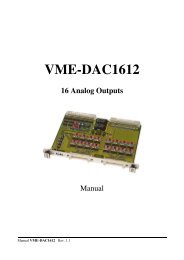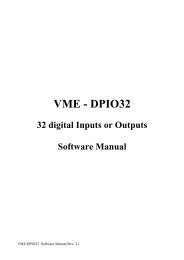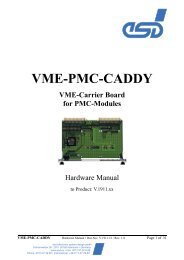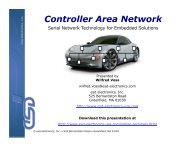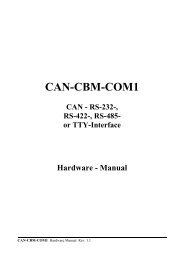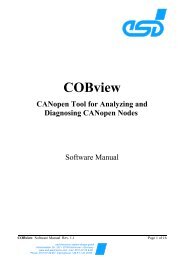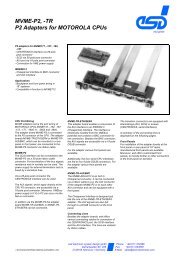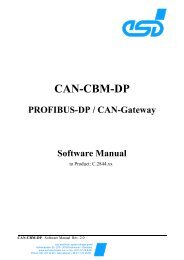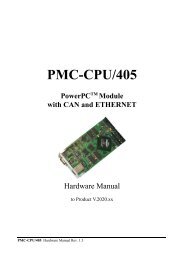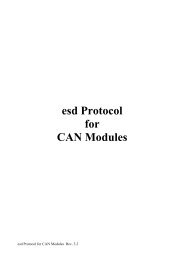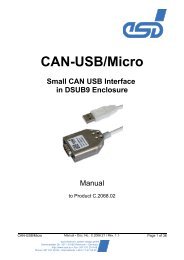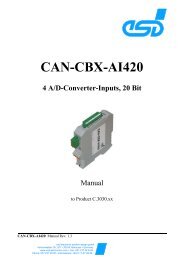CANopen - esd electronics, Inc.
CANopen - esd electronics, Inc.
CANopen - esd electronics, Inc.
Create successful ePaper yourself
Turn your PDF publications into a flip-book with our unique Google optimized e-Paper software.
<strong>CANopen</strong><br />
Higher Layer Protocol based on Controller Area Network (CAN)<br />
Presented by<br />
Wilfred Voss<br />
<strong>esd</strong> <strong>electronics</strong>, <strong>Inc</strong>.<br />
525 Bernardston Road<br />
Greenfield, MA 01301<br />
http://www.<strong>esd</strong>-<strong>electronics</strong>.us<br />
© <strong>esd</strong> <strong>electronics</strong>, <strong>Inc</strong>. • 525 Bernardston Road • Greenfield, MA 01301
What is <strong>CANopen</strong> ?<br />
• Higher Layer Protocol based on Controller Area Network (CAN)<br />
• All CAN features are available: Simplicity, high reliability, extremely short<br />
reaction/error recovery times<br />
• Master/Slave configuration, Multi-Master & direct communication between Slaves<br />
supported<br />
• Was originally designed for Motion Control<br />
• “Open” system, non-proprietary<br />
• Supports device profiles for Digital I/O, Analog I/O, Motion Controllers, Sensors,<br />
Actuator, etc.<br />
• All <strong>CANopen</strong> devices “speak the same language”<br />
• Ultimate goal: Manufacturer-independence, devices are interchangeable<br />
© <strong>esd</strong> <strong>electronics</strong>, <strong>Inc</strong>. • 525 Bernardston Road • Greenfield, MA 01301 Page 2
Higher Layer Protocols<br />
Why Higher Layer Protocols…?<br />
ISO 11898 7-Layer Reference Model<br />
• Data Transport of more than 8 bytes<br />
• Embedded Systems require appropriate communication model based on<br />
Master/Slave configuration<br />
• Network Management (Network Start-Up, Node Monitoring, Node<br />
Synchronization, etc.)<br />
© <strong>esd</strong> <strong>electronics</strong>, <strong>Inc</strong>. • 525 Bernardston Road • Greenfield, MA 01301 Page 3
Higher Layer Protocols<br />
<strong>CANopen</strong><br />
• Suited for embedded applications<br />
• Was originally designed for motion control<br />
• Developed/Maintained by CAN-in-Automation User Group<br />
• Manufacturer-Independent Protocol<br />
http://www.can-cia.org<br />
DeviceNet<br />
• Suited for industrial applications (floor automation)<br />
• Developed by Allen Bradley/Rockwell<br />
• Maintained by Open DeviceNet Association (ODVA)<br />
• Standard “controlled” by Allen Bradley/Rockwell<br />
http://www.odva.org<br />
SAE J 1939<br />
• Communication for vehicle networks (trucks, buses, etc.)<br />
• Standard developed by Society of Automotive Engineers (SAE)<br />
http://www.sae.org<br />
© <strong>esd</strong> <strong>electronics</strong>, <strong>Inc</strong>. • 525 Bernardston Road • Greenfield, MA 01301 Page 4
A Short History of <strong>CANopen</strong><br />
1983 Start of Bosch internal project to develop in-vehicle network<br />
1986 Official introduction of the CAN protocol<br />
1987 First CAN controller chips by Intel & Philips<br />
1991 Bosch publishes CAN specification 2.0<br />
1992 CAN in Automation (CiA) established<br />
1992 CAN Application Layer (CAL) protocol by CiA<br />
1992 First automobiles equipped with CAN (Mercedes Benz)<br />
1993 ISO 11898 standard published<br />
1994 First International CAN Conference (iCC)<br />
1994 Allen Bradley introduces DeviceNet<br />
1995 ISO 11898 amendment (extended frame format)<br />
1995 <strong>CANopen</strong> protocol introduced<br />
© <strong>esd</strong> <strong>electronics</strong>, <strong>Inc</strong>. • 525 Bernardston Road • Greenfield, MA 01301 Page 5
<strong>CANopen</strong> Applications<br />
• Semiconductor Industry (Wafer Handlers, etc.)<br />
• Robotics, Motion Control Applications<br />
• Passenger/Cargo Trains (Brake Control, Wagon Communication)<br />
• Aircrafts (AC, Seat Adjustment)<br />
• Elevators (e.g. Otis)<br />
• Building Technologies (Light & Door Control Systems, Sensors, etc.)<br />
• Medical Equipment (X-Ray, CAT scanners, etc.)<br />
• Household Utilities (Coffee Machine, Washer, etc.)<br />
• Aerospace (Satellites)<br />
© <strong>esd</strong> <strong>electronics</strong>, <strong>Inc</strong>. • 525 Bernardston Road • Greenfield, MA 01301 Page 6
CiA – CAN in Automation<br />
• International Users and Manufacturers Organization<br />
• Develops, supports CAN Standards and CAN based higher layer<br />
protocols<br />
• All activities are based on CiA members’ interest<br />
• North American office in Novi, MI<br />
http://www.can-cia.org<br />
CAN Newsletter<br />
To subscribe log on to:<br />
http://www.can-cia.org/newsletter/<br />
© <strong>esd</strong> <strong>electronics</strong>, <strong>Inc</strong>. • 525 Bernardston Road • Greenfield, MA 01301 Page 7
Benefits of Using <strong>CANopen</strong><br />
• Low Cost Implementation<br />
• Very Reliable, Error-Resistant<br />
• Worldwide Acceptance<br />
Main Benefit:<br />
• Last, but not least…<strong>CANopen</strong> Saves You Money!<br />
• Physical and Data Link Layer<br />
implemented in Silicon<br />
• SW Development Engineer is<br />
not involved with writing<br />
protocol features<br />
Be aware! Whenever you attempt to add software functions between the CAN Data Link Layer<br />
and the Application Layer, you will be adding functionalities that are already covered by off-theshelf<br />
available higher layer protocols such as <strong>CANopen</strong> and DeviceNet.<br />
© <strong>esd</strong> <strong>electronics</strong>, <strong>Inc</strong>. • 525 Bernardston Road • Greenfield, MA 01301 Page 8
Further <strong>CANopen</strong> Characteristics<br />
• Standardized protocol services provided, available as source code offthe-shelf<br />
• Protocol supports node IDs in addition to CAN message IDs<br />
• Supports up to 127 nodes in a network, each node requires a unique<br />
ID<br />
• Very low resources/memory print<br />
<strong>CANopen</strong> Slave ~10…20k ROM,
<strong>CANopen</strong> Reference Model<br />
© <strong>esd</strong> <strong>electronics</strong>, <strong>Inc</strong>. • 525 Bernardston Road • Greenfield, MA 01301 Page 10
Device Profiles<br />
Profile Device<br />
DS-401 Generic I/O modules<br />
DS-402 Drives and motion control<br />
DS-403 Not allocated<br />
DS-404 Measuring devices and closed loop controllers<br />
DS-405 IEC 61131-3 programmable devices<br />
DS-406 Encoders<br />
DS-407 Public transportation - Passenger Information Systems<br />
DS-408 Fluid Power Technology - Hydraulic drives and proportional valves<br />
DS-409 Vehicle door control<br />
DS-410 Declinometers<br />
DS-412 Medical Devices<br />
DS-413 Truck Gateways<br />
DS-414 Weaving Machines<br />
DS-415 Road Construction Machinery<br />
DS-416 Building Door Control<br />
DS-417 Lift Control Systems<br />
DS-418 Battery Modules<br />
DS-419 Battery Chargers<br />
DS-420 Extruder Downstream Devices<br />
More info:<br />
http://www.can-cia.de/services/cialiterature/<br />
© <strong>esd</strong> <strong>electronics</strong>, <strong>Inc</strong>. • 525 Bernardston Road • Greenfield, MA 01301 Page 11
Device Model<br />
© <strong>esd</strong> <strong>electronics</strong>, <strong>Inc</strong>. • 525 Bernardston Road • Greenfield, MA 01301 Page 12
Object Dictionary<br />
© <strong>esd</strong> <strong>electronics</strong>, <strong>Inc</strong>. • 525 Bernardston Road • Greenfield, MA 01301 Page 13
Object Dictionary<br />
Index Object<br />
0000h Not Used<br />
0001h – 025Fh Data Type<br />
0260h – 0FFFh Reserved<br />
1000h – 1FFFh Communication Profile Area<br />
2000h – 5FFFh Manufacturer Specific Profile Area<br />
6000h – 9FFFh Standardized Device Profile Area<br />
A000h – AFFFh Network Variables<br />
B000h – FFFFh Reserved for Future Use<br />
Common<br />
to any<br />
Device<br />
Device<br />
Specific<br />
© <strong>esd</strong> <strong>electronics</strong>, <strong>Inc</strong>. • 525 Bernardston Road • Greenfield, MA 01301 Page 14
Object Dictionary Addressing<br />
© <strong>esd</strong> <strong>electronics</strong>, <strong>Inc</strong>. • 525 Bernardston Road • Greenfield, MA 01301 Page 15
Object Dictionary Sample Entry<br />
Index Sub-Index Variable Data Type<br />
2092h 0h Number of Entries Unsigned8<br />
2092h 1h Baud Rate Unsigned16<br />
2092h 2h Number of Data Bits Unsigned8<br />
2092h 3h Number of Stop Bits Unsigned8<br />
2092h 4h Parity Unsigned8<br />
C Structure Equivalent<br />
typedef struct {<br />
} RS232;<br />
UNSIGNED8 NumberOfEntries;<br />
UNSIGNED16 BaudRate;<br />
UNSIGNED8 NumberOfDataBits;<br />
UNSIGNED8 NumberOfStopBits;<br />
UNSIGNED8 Parity;<br />
© <strong>esd</strong> <strong>electronics</strong>, <strong>Inc</strong>. • 525 Bernardston Road • Greenfield, MA 01301 Page 16
Communication Interface<br />
© <strong>esd</strong> <strong>electronics</strong>, <strong>Inc</strong>. • 525 Bernardston Road • Greenfield, MA 01301 Page 17
Communication Interface<br />
SDO – Service Data Object<br />
• Supports transfer of data of any length (Configuration data, program<br />
download, etc.)<br />
• Confirmed communication, each request results in a response<br />
PDO – Process Data Object<br />
• Provides “backward compatibility” to CAN<br />
• Transfer of max. 8 data bytes without protocol overhead<br />
• Used for real-time transmission of process data<br />
© <strong>esd</strong> <strong>electronics</strong>, <strong>Inc</strong>. • 525 Bernardston Road • Greenfield, MA 01301 Page 18
SDO – Service Data Object<br />
• Used for point-to-point communication between two nodes acting as<br />
SDO Client and SDO Server<br />
• Provides Read/Write access to all entries in Object Dictionary of a<br />
node<br />
• Read/Write Data is identified by Index & Sub-Index<br />
• Supports transfer of any length of data<br />
• Confirmed communication, each request results in a response<br />
• 2 CAN identifiers per SDO<br />
• Mainly used for device configuration and download/upload of large<br />
data blocks<br />
• Each <strong>CANopen</strong> device must support at least the Default-Server-SDO<br />
which always provides basic access to the device<br />
© <strong>esd</strong> <strong>electronics</strong>, <strong>Inc</strong>. • 525 Bernardston Road • Greenfield, MA 01301 Page 19
SDO – Transfer Modes<br />
• Expedited Transfer<br />
• Fast SDO transfer mode for data up to 4 bytes<br />
• Non-Expedited Transfer (Segmented Transfer)<br />
• SDO transfer mode for any length of data<br />
• Flow control after 7 transmitted bytes<br />
• Blocktransfer<br />
• SDO transfer mode for any length of data<br />
• Fast transfer method with flow control after block transfer of<br />
1…127 bytes<br />
© <strong>esd</strong> <strong>electronics</strong>, <strong>Inc</strong>. • 525 Bernardston Road • Greenfield, MA 01301 Page 20
SDO Protocol<br />
© <strong>esd</strong> <strong>electronics</strong>, <strong>Inc</strong>. • 525 Bernardston Road • Greenfield, MA 01301 Page 21
PDO – Process Data Object<br />
• Used for real-time transmission of process data<br />
• Provides very efficient transmission of data according to Consumer-<br />
Producer model<br />
• Transfer of max. 8 bytes without protocol overhead<br />
• Definition of transmitted data described per “PDO Mapping”<br />
• Unconfirmed transfer (correct reception of data is handled by CAN<br />
protocol)<br />
• 1 CAN identifier per PDO<br />
• Number of Transmit/Receive PDOs of a device according to application<br />
needs<br />
© <strong>esd</strong> <strong>electronics</strong>, <strong>Inc</strong>. • 525 Bernardston Road • Greenfield, MA 01301 Page 22
PDO – Transmission Modes<br />
• Event Driven<br />
• PDO transmitted upon occurrence of an event, e.g. change of<br />
input<br />
• An optional event timeout can be defined to trigger the<br />
transmission after a given time elapsed without any event<br />
• Polling (Remote Request)<br />
• PDO is transmitted only upon request from a remote device<br />
(per remote frame)<br />
• Synchronized<br />
• PDO is only transmitted upon reception of a SYNC message<br />
© <strong>esd</strong> <strong>electronics</strong>, <strong>Inc</strong>. • 525 Bernardston Road • Greenfield, MA 01301 Page 23
PDO Protocol<br />
© <strong>esd</strong> <strong>electronics</strong>, <strong>Inc</strong>. • 525 Bernardston Road • Greenfield, MA 01301 Page 24
PDO Mapping<br />
• Description of process data to be transmitted/received within a PDO is<br />
provided by “PDO Mapping”<br />
• Specifies how the data is “mapped” in a message<br />
• Process data to be transmitted/received within a PDO is specified in a<br />
“Mapping Parameter List” in form of a reference (Index, Sub-Index) in<br />
the Object Dictionary<br />
• Each PDO has its own “Mapping Parameter List” which can also be<br />
accessed through the Object Dictionary<br />
© <strong>esd</strong> <strong>electronics</strong>, <strong>Inc</strong>. • 525 Bernardston Road • Greenfield, MA 01301 Page 25
PDO Mapping - Example<br />
© <strong>esd</strong> <strong>electronics</strong>, <strong>Inc</strong>. • 525 Bernardston Road • Greenfield, MA 01301 Page 26
System Services<br />
• Notification of Device Errors<br />
• Emergency functionality to signal failures of application or<br />
communication<br />
• System-wide Synchronization of Processes<br />
• Simultaneous execution of processes<br />
• System-wide time reference<br />
• Common time base throughout the network<br />
© <strong>esd</strong> <strong>electronics</strong>, <strong>Inc</strong>. • 525 Bernardston Road • Greenfield, MA 01301 Page 27
Network Management<br />
© <strong>esd</strong> <strong>electronics</strong>, <strong>Inc</strong>. • 525 Bernardston Road • Greenfield, MA 01301 Page 28
Network Management<br />
• Network Management is based on Master/Slave relationship<br />
• Tasks of a <strong>CANopen</strong> Master/Manager<br />
• Controlling the network boot-up process<br />
• Verification and supervision of system consistency<br />
• Download of configuration data to new devices<br />
• Controlling the communication status of a device<br />
• Device Monitoring<br />
• Node-Guarding (Master/Slave Monitoring)<br />
• Heartbeat (Device status is transmitted as broadcast information,<br />
each device can monitor other devices)<br />
© <strong>esd</strong> <strong>electronics</strong>, <strong>Inc</strong>. • 525 Bernardston Road • Greenfield, MA 01301 Page 29
Device Communication State<br />
© <strong>esd</strong> <strong>electronics</strong>, <strong>Inc</strong>. • 525 Bernardston Road • Greenfield, MA 01301 Page 30
Further <strong>CANopen</strong> Network Services<br />
• Configuration Manager<br />
Enables automatic download of configuration data to new and<br />
unconfigured <strong>CANopen</strong> devices, e.g. in case of exchange of faulty device.<br />
Allows Plug&Play.<br />
• SDO Manager<br />
Manages dynamic establishment of SDO connections between devices<br />
during run-time.<br />
• Layer Setting Services<br />
Additional services for configuration of node ID and baud rate via CAN,<br />
no DIP Switches required.<br />
© <strong>esd</strong> <strong>electronics</strong>, <strong>Inc</strong>. • 525 Bernardston Road • Greenfield, MA 01301 Page 31
Further <strong>CANopen</strong> Network Services<br />
• Flying Manager<br />
Allows more than one <strong>CANopen</strong> Master/Manager, e.g. for backuppurposes.<br />
Negotiation of active Master performed automatically.<br />
• Redundancy (Fault Tolerant <strong>CANopen</strong>)<br />
Uses two independent CAN lines for communication.<br />
© <strong>esd</strong> <strong>electronics</strong>, <strong>Inc</strong>. • 525 Bernardston Road • Greenfield, MA 01301 Page 32
Implementation of <strong>CANopen</strong><br />
• <strong>CANopen</strong> protocol stack available off-the-shelf, e.g. Phytec<br />
http://www.phytec.com<br />
• Free <strong>CANopen</strong> Source Code<br />
http://www.microcanopen.com<br />
© <strong>esd</strong> <strong>electronics</strong>, <strong>Inc</strong>. • 525 Bernardston Road • Greenfield, MA 01301 Page 33
<strong>CANopen</strong> Development Tools<br />
What you need is…<br />
• The “regular” tools such as cross-compiler, emulator, etc.<br />
• <strong>CANopen</strong> Hardware Interface<br />
(Starter Kit)<br />
• <strong>CANopen</strong> API for your own programming<br />
• <strong>CANopen</strong> “Analyzer” Software<br />
• <strong>CANopen</strong> EDS Editor<br />
• <strong>CANopen</strong> Configuration Tool<br />
© <strong>esd</strong> <strong>electronics</strong>, <strong>Inc</strong>. • 525 Bernardston Road • Greenfield, MA 01301 Page 34
<strong>CANopen</strong> Development Tools<br />
What you need to consider…<br />
• Make sure the <strong>CANopen</strong> API is multi-tasking/multi-threading capable<br />
• Make sure that <strong>CANopen</strong> API is available for your RTOS<br />
• Don’t pay more than $1,000 for combination of PC CAN Interface<br />
Board and PC Analyzer Software.<br />
© <strong>esd</strong> <strong>electronics</strong>, <strong>Inc</strong>. • 525 Bernardston Road • Greenfield, MA 01301 Page 35
Literature<br />
A Comprehensible Guide To<br />
<strong>Inc</strong>ludes:<br />
Controller Area Network<br />
By Wilfred Voss<br />
ISBN 0-9765116-0-6<br />
• A Brief History of CAN<br />
• Main Characteristics<br />
• Message Frame Architecture<br />
• Message Broadcasting<br />
• Bus Arbitration<br />
• Error Detection & Fault Confinement<br />
• CAN Physical Layer<br />
• And more…<br />
For more information and for ordering this book log on to:<br />
http://www.copperhillmedia.com/CANbook.html<br />
© <strong>esd</strong> <strong>electronics</strong>, <strong>Inc</strong>. • 525 Bernardston Road • Greenfield, MA 01301 Page 36



